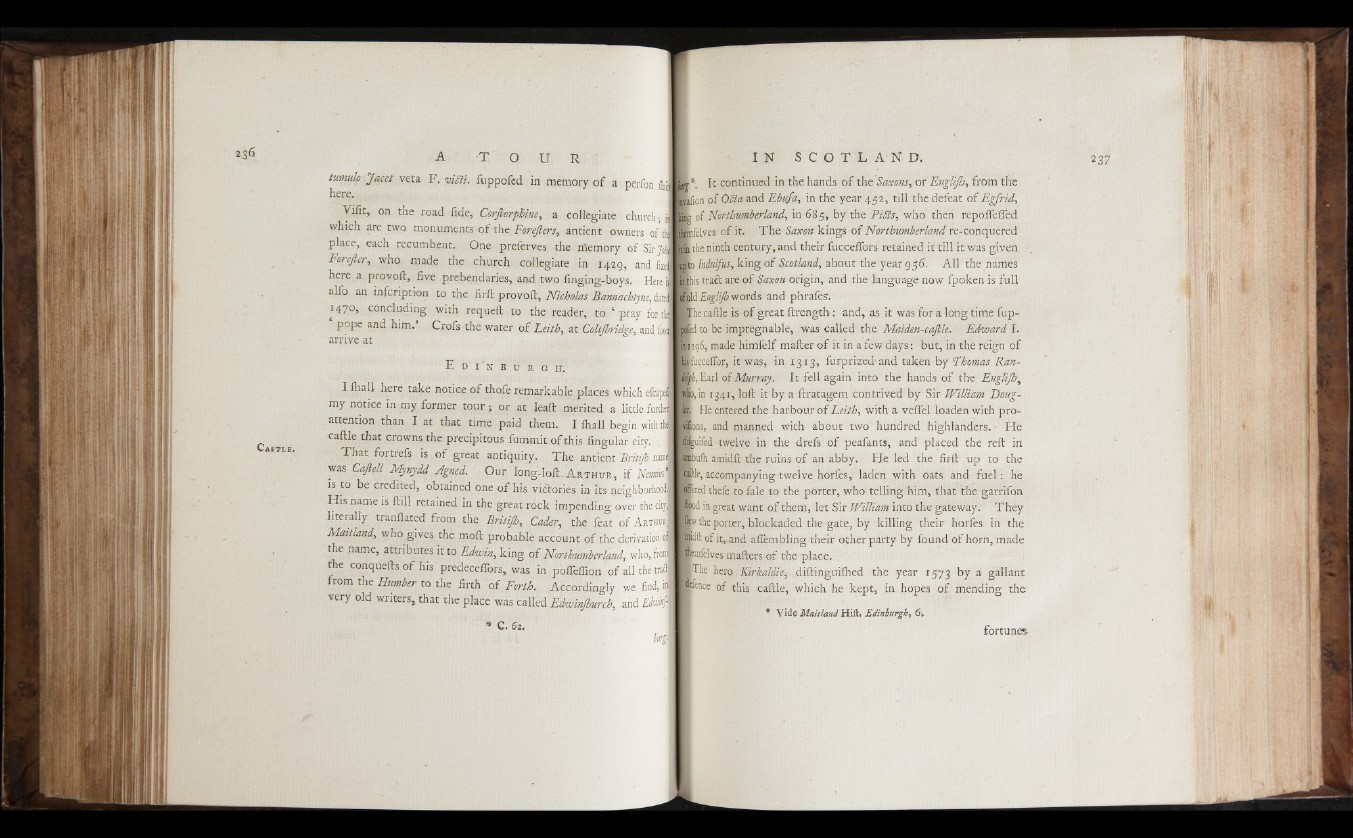
C a s t l e .
tumulo Jacet veta F. vitti, fuppofed in memory of a perfon Hail
here.
Vifit, on the road fide, Corftorphine, a coltegiate church;
which are two monuments of the Forejlers, antient owners of tlj
place, each recumbent. One preferves the memory of Sir [• 1
Forejter, who made the church collegiate in 1429, and fixe|
here a provoft, five prebendaries, and two fingjng-boys. Here i
alfo an ihfcription to the firft provoft, Nicholas Bannachtyne, datJ
147°, concluding with requeft to the reader, to | pray for til
‘ pope and him.1 Crofs the water of Leith, at Coltjbridge, and [<J
arrive at
E d i n b u r g h -.
I fliall here take notice of thofe remarkable places which efcapel
my notice in my former tour; or at leaft merited a little fnrthJ
attention than I at that time paid them. I lhall begin with t l
caftle that crowns the precipitous fummit.of this fingular city. .
That fortrefs is of great antiquity. The antient Britijh naml
was Caftell Mynydd Agned. Our long-lolLAitTHUR, i f Nenniusi
is to be credited, obtained one of his victories in its n e ig h b o rh o o d
His name is ftill retained in the great rock impending over the citw
literally tranflated from the Britijh, Cader, the feat of ArthmI
Maitland, who gives the molt probable account of the derivation 0]
the name, attributes it to Edwin, king of Northumberland, who, froJ
the conquefts of his predeceiTors, was in poflefiion of all the trail
from the Humber to the firth of Forth. Accordingly we find, i«
very old writers, that the place was called Edwinjburch, and
* C . 62.
It continued in the hands of the Saxons, or Englijh, from the
Ivifion of Otta and Ebufa, in the year 452, till the defeat of Egfrid,
■ of Northumberland, in 685, by the Pitts, who then repoffefled
Ihemfelves of it. The Saxon kings of Northumberland re-conquered
iti| the ninth century, and their fucceflors retained it till it was given
iip|o Indulfus, king of Scotland, abourthe year 956. All the names
jhis tratt are of Saxon origin, and the language now. fpoken is full
ofild £«g-/j/Z> words and phrafes-.
»he caftle is of great ftrength: and, as it was for a long time fup-
lifed to be impregnable, was called the Maiden-cajlle. Edward I.
in 1296, made himfelf mafter of it in a few days: but, in the reign of
hifjucceifor, it was, in 1313, furprized-and taken by “Thomas Ran-
', Earl of Murray. It fell again into the hands of the Englijhy
1 in 1341, loft it by a ftratagem contrived by Sir William Doug-
He entered the harbour of Leith, with a velfel loaden with pro-
vilons, and manned with about two hundred highlanders. • He
ifliguifed twelve in the drefs of peafants, and placed the reft in
ambulh amidft the ruins of an abby. He led the firft up to the
pftle, accompanying twelve horfes, laden with oats and fuel: he
■tred thefe to fale to the porter, who telling him, that the garrifon
■od in great want of them, let Sir William into the gateway. They
¡few the porter, blockaded the gate, by killing their horfes in the
■jiaft of it,.and affembling their other party by found of horn, made
■emfelves m afters of the place.
■The hero Kirkaldie, diftinguiihed the year 1573 by a gallant
■fence of this caftle, which he kept, in hopes of mending the
Vide Maitland Hid, Edinburgh, 6 .
fortunes